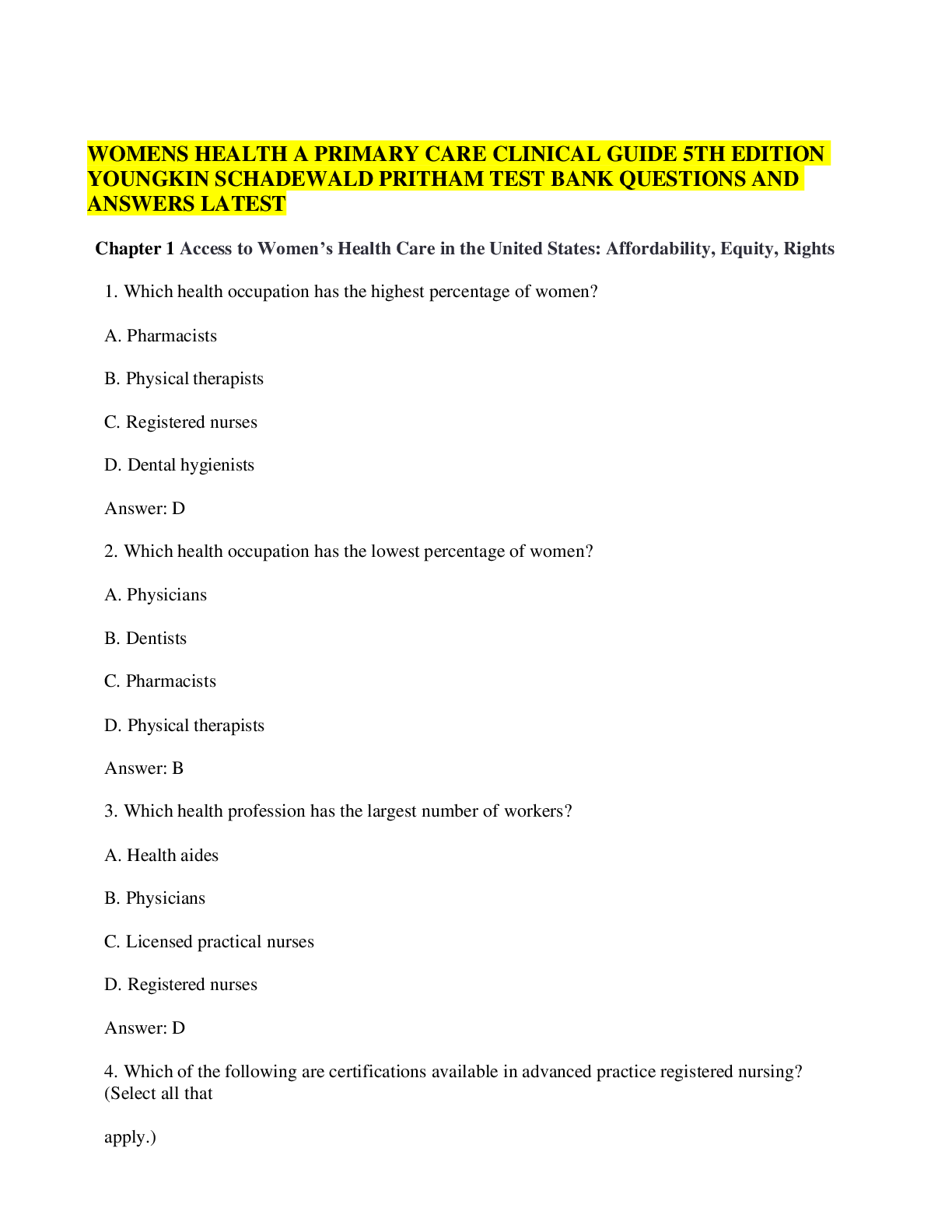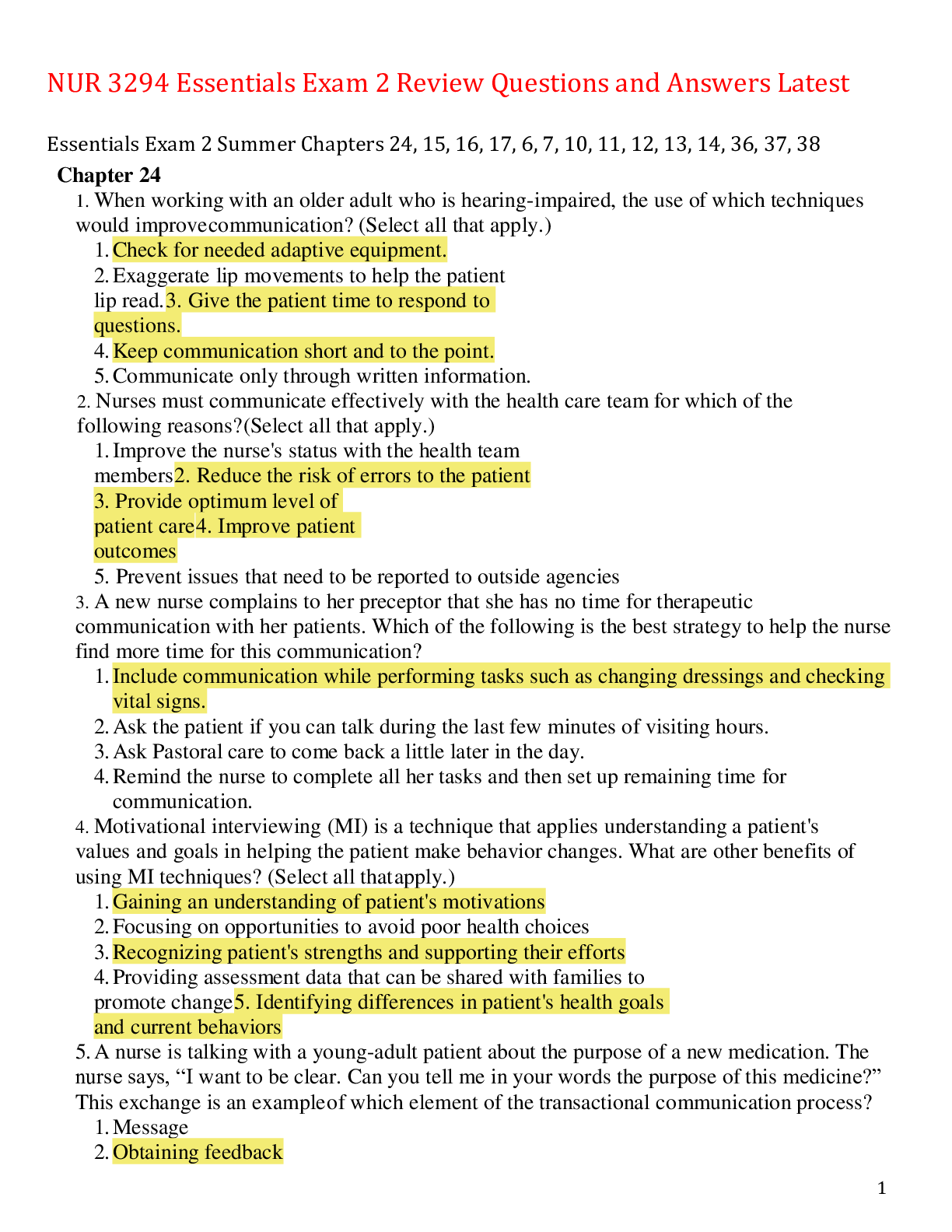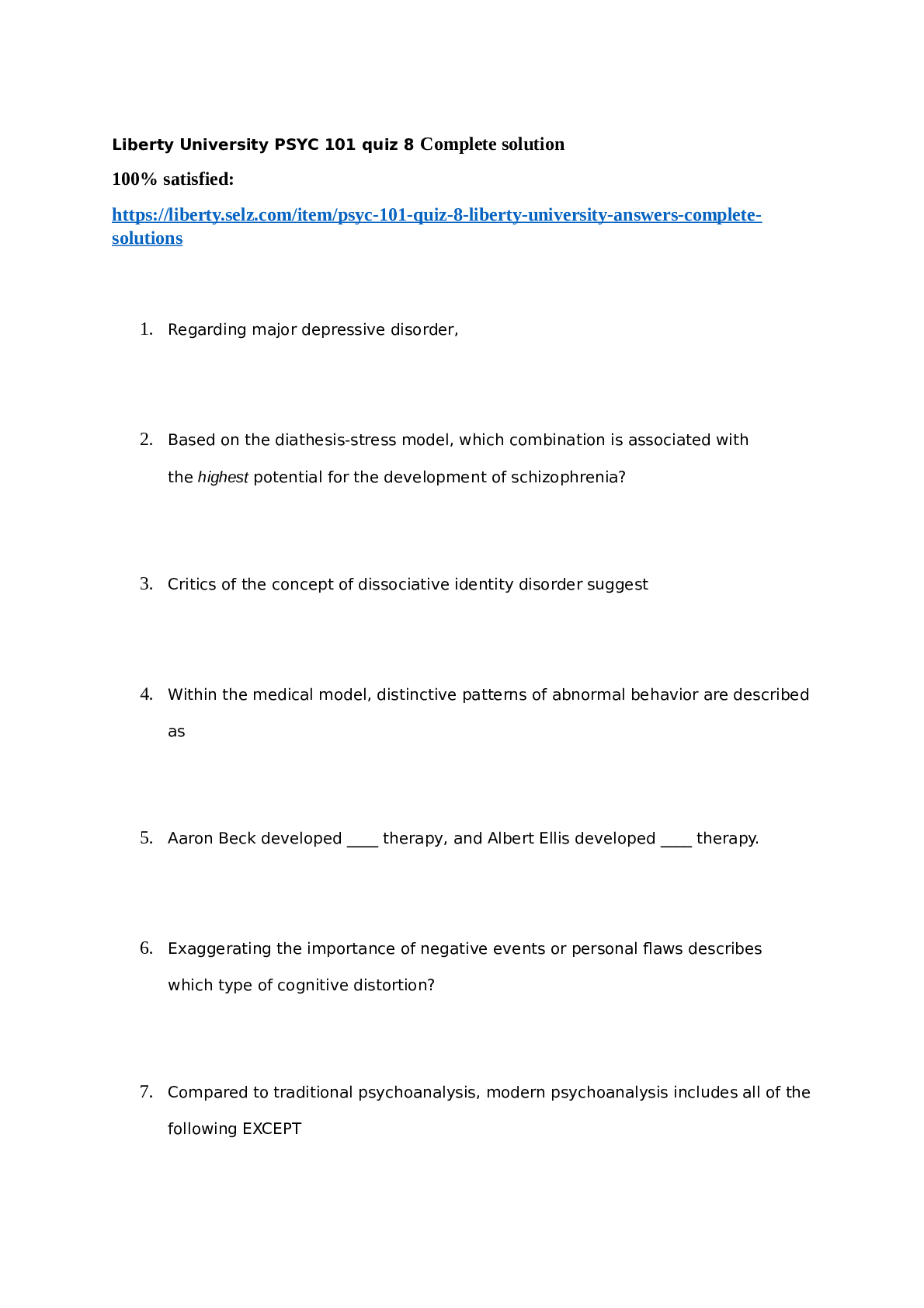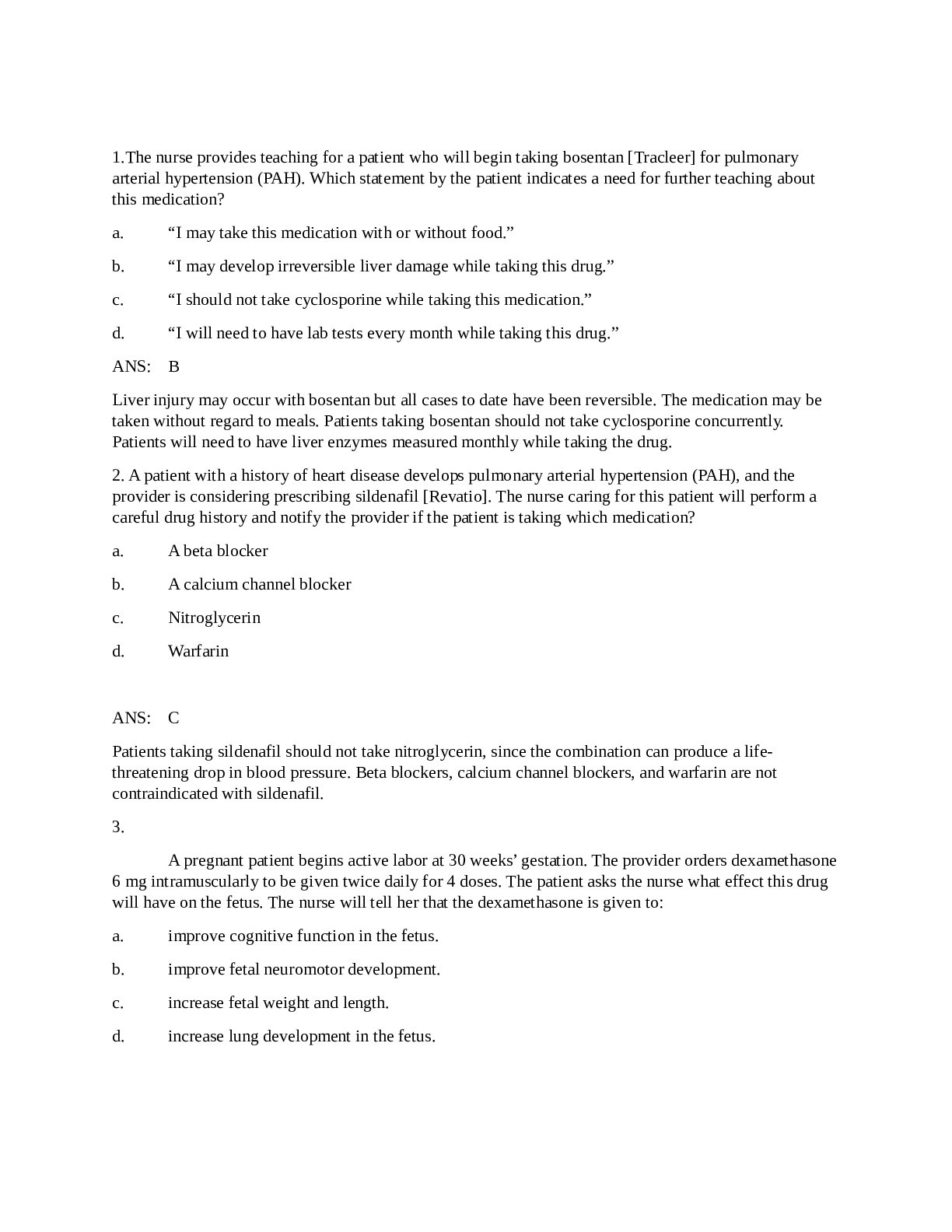*NURSING > TEST BANK > NUR3400 AGING BLUEPRINT MIDTERM Questions and Answers Latest updated 2022,100% CORRECT (All)
NUR3400 AGING BLUEPRINT MIDTERM Questions and Answers Latest updated 2022,100% CORRECT
Document Content and Description Below
NUR3400 AGING BLUEPRINT MIDTERM Questions and Answers Latest updated 2022 BLUEPRINT NUR3400 MIDTERM 1. Health is a broad term that encompasses attitudes and behaviors; holistically, health include... s wellness, which involves one’s whole being. In differentiating between health and wellness in health care, which of the following statements is true? a. Health is a broad term encompassing attitudes and behaviors. ANS: A Health is a broad term that encompasses attitudes and behaviors; holistically, health includes wellness, which involves one’s whole being. The concept of illness prevention was never considered by previous generations; throughout history, basic self-care requirements have been recognized. Wellness and self-actualization develop through learning and growth—as basic needs are met, higher level needs can be satisfied in turn, with ever- deepening richness to life. Wellness is possible when one’s health is compromised—even with chronic illness, with multiple disabilities, or in dying, movement toward a higher level of wellness is possible. 2. Individual interviews with the women to determine their interests and to avoid generalizing. The nurse plans activities for older women born between 1920 and 1930 and who reside in an assisted-living facility. Which is the best intervention for the nurse to implement? b. Conduct interviews for specific interests. ANS: B The nurse conducts individual interviews with the women to determine their interests and to avoid generalizing; as people live longer, they become more and more unique. Because most of these women are in their 80s and 90s were born between 1920 and 1930 and have generally spent their lives as homemakers, the nurse presumes to know what activities they will enjoy. The nurse avoids arranging group activities until individual interests are determined. In addition, the nurse must assess for allergies and individual fears of animals before exposing an older adult to a pet visit. Unless it is organized on a voluntary basis, the nurse avoids arranging visits by guest speakers. In addition, the nurse will assess each older woman before an outside visit to avoid embarrassing events, including incontinence and hearing and vision problems. 3. Older adults in most cultures usually have had experience with traditional methods that have worked as well as expected. Which of the following is a true statement about differing health belief systems? b. In most cultures, older adults are likely to treat themselves using traditional methods before turning to biomedical professionals. ANS: B Older adults in most cultures usually have had experience with traditional methods that have worked as well as expected. After these treatments fail, older adults turn to the formal health care system. Even in the United States, it is common for older adults to pray for cures or wonder what they did to incur an illness as punishment. The Ayurvedic system is a naturalistic health belief system practiced in India and in some neighboring countries. This belief is characteristic of a holistic or naturalistic approach. 4. Using the LEARN model (listen with sympathy to the patient’s perception of the problem, explain your perception of the problem, acknowledge the differences and similarities, recommend treatment, and negotiate agreement) An older adult who is a traditional Chinese man has a blood pressure of 80/54 mm Hg and refuses to remain in the bed. Which intervention should the nurse use to promote and maintain his health? c. Ask about his perceptions and treatment ideas. ANS: C Using the LEARN model (listen with sympathy to the patient’s perception of the problem, explain your perception of the problem, acknowledge the differences and similarities, recommend treatment, and negotiate agreement), the nurse gathers information from the patient about cultural beliefs concerning health care and avoids stereotyping the patient. In the assessment, the nurse determines what the patient believes about caregiving, decision making, treatment, and other pertinent health-related information. Speaking with the health care provider is premature until the assessment is complete. Unless he accepts the beliefs, principles of the holistic health system can be potentially unsuitable and insulting for this patient. Unless he accepts the treatments, consulting with a practitioner of Chinese medicine can also be unsuitable and insulting for this patient. 5. Working with an interpreter The nurse prepares an older woman, who is Polish, for discharge through an interpreter and notes that she becomes tense during the instructions about elimination. Which intervention should the nurse implement? b. Ask the older woman how she feels about this topic. ANS: B When working with an interpreter, the nurse closely watches the older adult for nonverbal communication and emotion regarding a specific topic and therefore validates the assessment about the older adult’s tension before proceeding. Because the nurse notices her tension, the nurse temporarily suspends the preparation to validate her assessment. If the nurse proceeds and the older adult is uncomfortable discussing elimination, then important instructions can be missed, leading to adverse effects for the older adult. Repeating the instructions can aggravate the older adult’s discomfort. Instructing the older adult to repeat the nurse’s instruction ignores her needs. 6. Normal changes in older adults (Secretion of thyroid hormones tends to decrease with age. Decreased kidney function.) Decreased functioning of which physical structure is likely to result in decreased metabolism in older adults? b. Thyroid gland ANS: B Secretion of thyroid hormones tends to decrease with age, resulting in a greater likelihood of a slower metabolism, hypothyroidism, and thinning hair and nails. Decreased kidney function leads to decreased glomerular filtration rate and the ability of the kidneys to concentrate urine and clear waste. Decreasing brain function tends to result in decreased cognitive functioning. Osteoclastic activity tends to decrease with age, increasing the risk for osteopenia and osteoporosis. 7. Signs of infection. Skin Care Which change in the skin is abnormal in an older person? b. Red, swollen 3-day-old wound ANS: B Although the skin of an older person may require 48 to 72 hours to mount an initial inflammatory response to a wound, increasing redness after that time, particularly with purulent discharge, is a sign of infection. This change is normal as ridges in the skin are lost. Melanin distribution becomes more uneven with age. Hair is commonly lost from the legs and other areas of older adults. Hair loss from the legs is not a sign of peripheral vascular disease. 8. Exercises recommendations for older adults. An older woman tells the nurse practitioner that she fears her family will place her in a nursing home because she developed stress incontinence. Which recommendation should the nurse implement? c. Recommend exercises to strengthen the pelvic floor. ANS: C The nurse practitioner recommends pelvic floor exercises to strengthen the pelvic floor and the muscles that surround the urethra, vagina, and rectum to decrease the incidence of stress incontinence. Stress incontinence is usually caused by weakened pelvic floor muscles; therefore, eliminating caffeinated beverages can be an ineffective treatment. Arranging a family conference is premature and potentially embarrassing for older adults. Many therapies are available to decrease this older adult’s incontinence. Scheduled voiding is recommended at 2- to 4-hour intervals during the day and at 4-hour intervals at night. Exercises are prescribed for older adults as therapy to improve which one of the following qualities? b. Muscle strength ANS: B Exercises that improve muscle strength are important for balance, strong bones, and metabolic processes. Relative intensity is the level of effort required by a person to an activity. When using relative intensity, people pay attention to how physical activity affects heart rate and breathing. Muscle strength is not a therapeutic concern. Muscle retraining refers to muscles that have been trained, detrained, and trained again and is not a therapeutic concern. Muscle definition is a quality valued by bodybuilders, but it is not a therapeutic concern. A 75-year-old woman asks a nurse, “I know I should be moving, but how much is the right amount of exercise for me?” The best response of the nurse is: a. “You need to engage in 30 minutes of moderate intensity exercise on at least 5 days a week.” ANS: A Older adults need at least 2 hours and 30 minutes (150 minutes) of moderate-intensity aerobic activity (e.g., brisk walking, swimming, bicycling) every week and muscle-strengthening activities on 2 or more days that work all major muscle groups (legs, hips, abdomen, chest, shoulders, and arms). The nurse wants to use exercise according to the recommendations of the American Geriatrics Society (AGS) for an older woman who lost her balance and fell. Which nursing intervention is suitable for this older adult according to the AGS? b. Provide information on group exercises for balance training. ANS: B The AGS states that group exercises can be effective to improve balance as part of a fall prevention program for older adults. Using an assistive device can help prevent falls; however, assistive devices are not part of an exercise program. Although the AGS states that the relationship between exercise and reducing the risk for falls is strong, the recommended type, duration, and intensity of the exercises are not clear. The AGS states that to improve balance with exercise, an older adult must participate in exercise for at least 10 weeks. 9. Tornstam’s theory The nurse plans care for older adults who are in good health but isolated from their families. If the nurse’s goal is to move the adults toward gerotranscendence, which intervention should the nurse use in the plan of care? d. Help each person with individual activities. ANS: D In Tornstam’s theory, aging offers the potential for gerotranscendence, a culmination of an individual’s life, wisdom, and spiritual growth that allows older adults to live contentedly with and without social activities. An older adult spends more time on meditation and solitude and less time on materialism and self-consciousness about body image. Individual activities or self-selected activities are satisfactory. Solitude is satisfactory. Midlife patterns are no longer relevant to contentment. 10. Appropriate documentation Which of the following is a true statement about documentation? a. Nurses should keep records of patients’ wishes. ANS: A Entering patients’ expressed wishes in the medical or clinical record helps ensure that the interdisciplinary team respects these wishes. According to regulations after the enactment of the Health Insurance Portability and Accountability Act (HIPAA), the patient has access to his or her own medical records and may designate others to have access. The OASIS is used to measure outcomes for quality improvement purposes; it does not contain all of the necessary information for care, such as vital signs. The MDS should be completed jointly by all members of the interdisciplinary team. 11. The appropriate and accurate use of assessment and documentation instruments will increase the likelihood of obtaining reliable, useful data, especially data that can be used to monitor changes over A nurse conducts a comprehensive assessment of an older adult. The nurse uses the Mini-Cog, a valid and reliable assessment tool to assess the individual’s mental status. The nurse understands that the benefit of using a standard assessment tool is that: b. a standard assessment tool will increase likelihood of obtaining accurate data. ANS: B The appropriate and accurate use of assessment and documentation instruments will increase the likelihood of obtaining reliable, useful data, especially data that can be used to monitor changes over time. Medicare and Medicaid do not mandate the use of standardized tools, and reimbursement rates are not linked to specific assessment tools. Assessment tools are not likely to impact the nurse–patient relationship. 12. Teaching the family how to feed patient. A nurse is caring for an older client in the community who has a diagnosis of advanced dementia. The client’s caregiver reports that over time, the patient has progressively decreased her oral intake and at present is not swallowing the food put in her mouth. The patient’s caregiver reports that the primary care provider has contacted her and asked her to consider placement of a feeding tube. The caregiver asks the nurse what considerations they should be thinking about in making the decision. The nurse responds based on the knowledge that b. careful hand feeding for patients with advanced dementia is recommended instead of feeding tubes. ANS: B The American Geriatrics Society recommends careful hand feeding for patients with advanced dementia rather than feeding tube placement. Research demonstrates that there are no better outcomes for patients who have feeding tubes. Feeding tubes are high risk and problem prone particularly in older patients with dementia. 13. Weight loss causes Which age-related change contributes to anorexia and weight loss in older adults? b. Fewer taste buds ANS: B The number of taste buds declines with age and can decrease the enjoyment of food, which can result in less motivation to eat and a resulting weight loss or loss of appetite. Saliva production tends to decrease with age. As long as dentures fit properly and the wearer practices good oral hygiene, wearing dentures does not necessarily contribute to anorexia and weight loss. Older adults tend to lose enamel. 14. Risks for dehydration. Which increases the risk for chronic dehydration in older adults? b. Poor cognitive function ANS: B Poor cognitive functioning, depending on others for ambulation, living in a residential facility, and having four chronic illnesses are factors that increase the risk of chronic dehydration. An overuse of diuretic agents is more likely to cause acute dehydration. Dry mucous membranes are reliable indicators of chronic dehydration. Fluid loss from vomiting leads to acute dehydration. 15. Older adults and sleep Which of the following is a true statement about sleep in older adults? a. The time spent in bed increases, but the time spent asleep decreases. ANS: A Older persons tend to spend less time asleep than younger persons, although they spend more time in bed. This statement is true because sleep takes longer to arrive and is more fragmented. Leg movements during sleep often tend to increase with age. REM sleep becomes more evenly distributed with age. Stage III sleep decreases with age and virtually disappears in older adults. Which of the following is a true statement about sleeping in older adults? b. Sleep disturbances in older adults can be caused by chronic illness. ANS: B Chronic illness is an internal risk factor that can contribute to sleep disorders. It takes older adults more time to fall asleep, and older adults are awakened throughout the night more frequently than younger people. Benzodiazepines should not be used to induce sleep; these substances are highly addictive, and if their administration is suddenly withdrawn, then rebound insomnia can occur. In addition, older adults who take benzodiazepines for sleeping are more likely to experience a “hangover” after waking that can increase the risk of accidents and injuries. The times of day that medications are given can also contribute to sleep problems —for example, a diuretic given before bedtime or sedating medications given in the morning. 16. Assessment of the skin in the older adults. Which change in the skin is abnormal in an older person? b. Red, swollen 3-day-old wound ANS: B Although the skin of an older person may require 48 to 72 hours to mount an initial inflammatory response to a wound, increasing redness after that time, particularly with purulent discharge, is a sign of infection. This change is normal as ridges in the skin are lost. Melanin distribution becomes more uneven with age. Hair is commonly lost from the legs and other areas of older adults. Hair loss from the legs is not a sign of peripheral vascular disease. Which of the following is an important consideration about the skin of older adults? c. Skin becomes more vulnerable to damage. ANS: C Thin skin–reduced sebaceous protection, vascular insufficiency, and longer periods in stationary positions promote skin damage for older adults. Because moisture is lost more rapidly from the skin of older adults, excessive use of soap tends to dehydrate the skin more severely than it does in younger people. Sweat gland activity does not increase in older age, but moisture is lost more rapidly because the skin is thinner and sebum secretion is reduced. Changes of skin color in areas exposed to the sun are of greater concern than those in unexposed areas. 17. Risk for hypothermia An older man was oriented and responded appropriately in the hospital, but he is now disoriented and confused in his home after discharge. Which of the following issues is the first that the home nurse should examine to determine whether an environmental issue is contributing to the patient’s condition at home? b. Temperature of household ANS: B Older adults are at higher risk of hypothermia in the community because hypothermia is difficult to detect and because, as hypothermia sets in, the older adult can respond to a lower temperature. This man has clinical indicators of hypothermia; therefore, the home care nurse first assesses the ambient temperature for a baseline determination because the household temperature should have the most profound impact on his body temperature. Asking about shivering can be ineffective with an older adult who is confused and disoriented; the response can be incorrect. However, to display respect, the nurse should ask the question. The type of food preparation can offer additional clues about the older adult’s hypothermia and mental status; if he is eating cold foods such as sandwiches and yogurt, then he can be unwittingly contributing to the problem. The presence of radon in the home may lead to lung cancer, not confusion. 18. Cross cultural Care A home care nurse is caring for an older patient from a different culture who is bedbound and high risk for development of a pressure ulcer. The nurse discusses the plan of care with the patient’s daughter, emphasizing the importance of turning every 2 hours, and posts a turning clock on the wall. When the nurse returns later in the week, the turning clock has been removed, and the patient’s daughter reports that she turns her mother occasionally. She states, “I am taking very good care of my mother. You just don’t understand—our ways do not involve doing things on schedules.” The best response by the nurse is: d. “How can we best work together to provide the best care for your mother?” ANS: D In providing cross-cultural care, it is important that the nurse work with the patient and family and listen carefully and find a way to include the values and beliefs of the patient in the plan of care. 19. Physiological changes in the older adult. Which physiological change in the brain is the reason the nurse allows more time for answering questions with older adults? d. Atrophy of dendrites in the cerebral cortex ANS: D Dendrites are the receiving end of neurons (receiving electrochemical signals) and the branched ends extending from the cell body. The atrophy of dendrites contributes to slower thought processes with aging because the synapses are impaired; this changes the transmission of neurotransmitters that are vital in the transmission of an electrical impulse from neuron to neuron. The secretion of cholinesterase, the enzyme that inactivates acetylcholine in the synapse, does not increase with aging. Changes in the transmission of neurotransmitters are associated with the atrophy of dendrites. The spinal cord and the cerebral cortex lose neurons with age, the cerebral cortex more than the spinal cord. 20. Falls risk After assessing an older man in his bed, the nurse determines that he is at high risk for falls. The nurse leaves the room to get a fall risk sign and returns to find him on the floor pleading for help. Which of the following was the most important intervention the nurse should have implemented to prevent this event? d. Instruct the patient to call for help. ANS: D The nurse accomplished the most important aspect of fall prevention with the assessment. However, in an attempt to communicate the fall risk to other staff members, the nurse failed to communicate properly to the patient about fall prevention before leaving the room. Calling for someone to bring the sign would have been a reasonable approach to communicating the risk of falls, but it does not take the place of directly instructing the patient about prevention. The needs of an older adult can contribute to the risk of falls as an individual leans and reaches for something; therefore, call bell instructions are a reasonable approach for preventing falls. However, before providing the call bell instructions, the nurse needed to tell him to call for help. A urinal and drinking water are common items that an older man needs, but reaching for them can contribute to falls. Which attempt by the family to prevent an older frail adult from falling causes the home health nurse concern? c. Keeping the side rails up on the client’s bed at night ANS: C Keeping side rails up have proven to be a risk factor for falls rather than a positive intervention. The remaining interventions are appropriate and generally effective. Which factors in the patient care environment should be routinely assessed to decrease the risk of falls? (Select all that apply.) a. Outdoor grounds b. Appropriate footwear d. Grab bars in place ANS: A, B, D The outdoor grounds should be checked for uneven areas, such as breaks in the sidewalk and items the patients could trip over. Ensuring that patients have the appropriate footwear in important to decrease the risk for falls. Raised bed rails can be considered a restraint. Grab bars are considered assistive devices and can decrease the risk for falls or injuries. Which assessment finding is a contributor to an older client’s risk for falls? (Select all that apply.) a. The client is awaiting cataract surgery on right eye. b. The client type 2 diabetes is poorly controlled with diet and exercise alone. c. The client reports a fall in the past year. ANS: A, B, C The correct options are those that affect the client’s vision, presence of factors affecting sensations in the legs and feet, and a history of falls. There is no research to connect the risk of falls with either of the skin conditions mentioned. Tai Chi improves balance, which decreases the risk of falls. 21. The atrophy of dendrites and its effects on older adults. Which physiological change in the brain is the reason the nurse allows more time for answering questions with older adults? d. Atrophy of dendrites in the cerebral cortex ANS: D Dendrites are the receiving end of neurons (receiving electrochemical signals) and the branched ends extending from the cell body. The atrophy of dendrites contributes to slower thought processes with aging because the synapses are impaired; this changes the transmission of neurotransmitters that are vital in the transmission of an electrical impulse from neuron to neuron. The secretion of cholinesterase, the enzyme that inactivates acetylcholine in the synapse, does not increase with aging. Changes in the transmission of neurotransmitters are associated with the atrophy of dendrites. The spinal cord and the cerebral cortex lose neurons with age, the cerebral cortex more than the spinal cord. 22. The NGNA was formed specifically for all levels of nursing personnel: registered nurses (RNs), licensed practical nurses (LPNs), licensed vocational nurses (LVNs), and certified nursing assistants (CNAs). Which gerontological nursing organization welcomes nurses from all educational backgrounds? a. The National Gerontological Nursing Association (NGNA) ANS: A The NGNA was formed specifically for all levels of nursing personnel: registered nurses (RNs), licensed practical nurses (LPNs), licensed vocational nurses (LVNs), and certified nursing assistants (CNAs). The NCGNP is, as its name implies, limited to nurse practitioners. The NADONA/LTC is, as its name implies, limited to directors and assistant directors of nursing. The ASA is an interdisciplinary organization not limited to nurses. 23. Gerontological nursing in nursing school curricula. Which is an accurate statement regarding gerontological nursing education? c. When content is integrated throughout a curriculum, less than 25% is devoted to geriatric care. ANS: C When content is integrated throughout the curriculum, less than 25% of the content is devoted to geriatric care. Only recently has gerontological nursing content begun to appear in nursing school curricula. Most nursing schools still do not have such courses. At present, no minimum requirements exist for the coverage of care of older adults. 24. Projections in increase of older population by 2050. Based on current demographic data, which of the following statements identifies a predictive trend regarding the health care needs of society? b. More nursing services will be required to serve the needs of the population older than 85 years of age. ANS: B Projections are that 20% of the American population will be older than 65 years of age by 2050, with those older than 85 years showing the greatest increase in numbers. Most nurses can expect to care for older people during the course of their careers. By 2050, the United Nations predicts that more Americans will be older than the age of 60 years than those younger than the age of 15 years. Older people are better educated and more affluent and expect a higher quality of life than their elders had at their age. 25. HMO Which of the following statements is true about health care costs for older adults in the United States? c. Health maintenance organizations (HMOs) can obtain an exemption from Medicare’s per capita spending limit. ANS: C If an HMO is granted a per capita waiver, it cannot refuse an applicant on the basis of a preexisting condition. Medicare Part A covers hospitalizations and other inpatient care. Medicare Part B, which is optional insurance purchased by the beneficiary, covers outpatient services, physician visits, some therapy sessions, and some home health care. Older adults that pay a fixed premium and low out-of-pocket costs is a description of an HMO rather than a PPO. Medicaid is income dependent; therefore, not all older adults receive Medicaid. 26. Informed consent An older patient is admitted to the hospital for treatment of pneumonia. The patient has a court-appointed conservator who manages her finances. The nurse understands that c. the presence of a conservator does not mean the patient cannot give informed consent. ANS: C Guardians and conservators are individuals, agencies, or corporations that have been appointed by the court to have care, custody, and control of a disabled person (ward) and manage his or her personal or financial affairs (or both) when the person has been found (adjudicated) to lack capacity. A conservator is appointed specifically to control the finances of the ward. The presence of a conservator does not mean the individual cannot give consent. The conservator is not the same as a health care proxy. The nurse needs to care for the patient in the same manner regardless of the presence of a conservator. 27. Nutrition in the older adult Which of the following is a true statement about nutrition for older adults? b. Transportation can be a critical factor in nutritional insufficiency in older adults. ANS: B Older persons often have difficulty in obtaining adequate transportation to remote supermarkets and may choose light-weight but less nutritious food items rather than heavy fresh fruits and vegetables. Cholesterol phobia, or the excessive concern over cholesterol control, can contribute to malnutrition in older adults. Every culture has some particular foods and ways of preparing food that can bring great comfort for a person raised in that culture. Title VII of the Older Americans Act provides funding for outreach centers that serve social meals open to all older adults, regardless of their ability to pay. 28. Cleaning of dentures Which of the following is a true statement about dental health in older adults? c. Dentures should be cleaned once a day by brushing and soaking in a cleaning solution. ANS: C Careful cleaning of dentures is necessary to prevent the buildup of residues that contribute to staining and odor, as well as to infection. Older adults can lose teeth, but more adults are retaining their teeth into older age. Tooth loss is most often a result of periodontal disease. Inadequate saliva production (xerostomia) is a common problem for older persons. Bleeding gums is a sign of periodontal disease. 29. Constipation in the older adult. An older adult who is on bed rest after surgery is prescribed morphine for pain. Which of the following is the nurse’s priority for preventive care? a. Constipation ANS: A This older adult is at high risk for developing constipation as a result of being on bed rest and being prescribed an opiate for pain. A decrease in activity, combined with the use of an opiate, often leads to constipation, not diarrhea. Appetite can be poor for the first few days after surgery, but it often returns without incidence. Decreased fluid intake is often supplemented with intravenous fluids for the first few days after surgery. 30. What causes constipation in older adults? Which of the following statements is true about analgesic medications for older adults? b. Stool softeners and laxatives should be used with opioids. ANS: B Opioids often cause constipation and necessitate bowel stimulation to prevent constipation. A bowel regimen should be instituted at the same time as opioid treatment. Because of changes in metabolism with aging, opioids have a greater and longer lasting analgesic effect in older patients. NSAIDs can cause gastrointestinal bleeding, kidney and liver damage, and drug interactions with potentially fatal results. The maximum daily dose of acetaminophen is 4000 mg, and the limit is lower for patients with kidney or liver failure and patients who use alcohol. A typical dose is two 500-mg (“extra-strength”) tablets. 31. Risk factors for sleep disorders. Which of the following is a true statement about sleeping in older adults? b. Sleep disturbances in older adults can be caused by chronic illness. ANS: B Chronic illness is an internal risk factor that can contribute to sleep disorders. It takes older adults more time to fall asleep, and older adults are awakened throughout the night more frequently than younger people. Benzodiazepines should not be used to induce sleep; these substances are highly addictive, and if their administration is suddenly withdrawn, then rebound insomnia can occur. In addition, older adults who take benzodiazepines for sleeping are more likely to experience a “hangover” after waking that can increase the risk of accidents and injuries. The times of day that medications are given can also contribute to sleep problems —for example, a diuretic given before bedtime or sedating medications given in the morning. 32. Hospitalizations and sleeping patterns. During the night, an older woman complains to the nurse that she has not slept more than 2 hours since admission to the hospital. Which intervention should the nurse implement to increase the duration of this woman’s sleep? a. Inquire about her sleep habits used at home. ANS: A Hospitalization often disrupts normal sleeping patterns; therefore, reestablishing these patterns is the best first step to improving the quality of sleep in the hospital. Avoiding napping during the day is a reasonable approach to complaints of sleeplessness, but it may not be this woman’s problem. Sleep is increasingly fragmented in older adults; however, understanding that issue may or may not help this woman sleep for longer periods. A book or movie can help some people become drowsy, but becoming drowsy will not usually increase the quality or duration of sleep. In fact, books and movies can be stimulating and decrease the ability to fall asleep. 33. Staging pressure ulcers. Which of the following is a true statement about impaired skin integrity? c. Muscle and fat cannot regenerate. ANS: C Because subcutaneous tissues such as muscle and fat are not regenerated but simply replaced by granular tissue, the staging of pressure ulcers is never reversed. Stasis ulcers are the result of the leakage of blood from veins beneath the skin. Pressure ulcers are caused when perfusion to the tissue is impaired by external pressure that causes tissue injury and death. Sufficient nutrition is essential in maintaining skin integrity. 34. Prevention of skin cancer. A nurse will be conducting an educational session on preventing skin cancer at a local senior citizen’s center. Which should the nurse include in the session? a. Squamous cell cancer may appear similar to a wart. ANS: A Squamous cell lesion may appear like a wart and be hard with defined borders. Basal cell carcinoma is more prevalent in fair-skinned older men and begins as a pearly papule. A multicolored, raised lesion with asymmetrical borders characterizes melanoma. 35. Herpes Zoster in adults. Which infection-control practice should the nurse implement when caring for an older adult who has active herpes zoster? d. Cover ruptured skin lesions with a nonabsorbent dressing. ANS: D Herpes zoster in an adult is spread through contact; therefore, the nurse applies the principles of contact precautions when caring for an older adult with active herpes zoster. To reduce the transmission of the virus through contact, the nurse keeps the ruptured lesions covered. A face shield is not necessary when caring for an adult with herpes zoster; however, a gown can be necessary during dressing changes or any time that splashing can occur. Airborne precautions and a respirator-type mask are indicated for infections transmitted through the air. Because active herpes zoster in an older adult is transmitted through contact, negative airflow is not indicated. 36. Scabies in adults. An older person is admitted to the hospital with an exacerbation of congestive heart failure. The nurse notes that the patient complains of severe itching at night and has a red rash on her torso. The patient is diagnosed with scabies. The patient asks the nurse, “How did I get something like this?” The best response by the nurse is: a. “Scabies is highly contagious and spreads easily through physical contact.” ANS: A Scabies is caused by a tiny burrowing mite and is highly contagious and easily passed by an infected person to family members and others in close contact by direct physical content. It is not limited to older adults, and age- related changes in the skin do not cause it or make a person more susceptible. Individuals with multiple chronic conditions are not more likely to develop scabies than other individuals. There is no evidence that medications can make an individual more susceptible. 37. Zostavax is recommended for all persons 60 years of age and older who have no contraindications to the vaccine including persons with a previous episode of herpes zoster (HZ) and those with chronic conditions A nurse is providing an educational session on vaccines to a group of older adults. The nurse is discussing the zoster vaccine (Zostavax). Which of the following information should the nurse include in the education? b. Zostavax is recommended for all individuals older than 60 years of age that have no contraindications to the vaccine. ANS: B Zostavax is recommended for all persons 60 years of age and older who have no contraindications to the vaccine including persons with a previous episode of herpes zoster (HZ) and those with chronic conditions. The vaccine does not guarantee that an individual will not get HZ; however, individuals who get the vaccine cut their risk in half and if they do get HZ, it is likely that they will get a milder case. 38. Side rails and restrains Which attempt by the family to prevent an older frail adult from falling causes the home health nurse concern? c. Keeping the side rails up on the client’s bed at night ANS: C Keeping side rails up have proven to be a risk factor for falls rather than a positive intervention. The remaining interventions are appropriate and generally effective. The health care provider has not ordered the use of a restraint for an alert patient at high risk for falling. The nurse should implement which side rail use? b. One -length rail ANS: B The use of one -length rail is not considered a restraint; it can be used to assist the patient in getting in and out of bed. Two full-length rails and four -length rails would be considered a restraint. The use of no side rails is not considered a restraint; however, the use of one rail to maneuver in and out of bed may be most beneficial to the patient. 39. Get Up and Go test. The nurse assesses the quality of which of the following patient characteristics when applying the Get Up and Go test from the Hendrich II Fall Risk Model? c. Balance ANS: C Using the Get Up and Go test, the quality of the older adult’s movements is assessed. The nurse instructs the individual to rise from a chair, walk, and return to the chair and be seated. The stride is not specifically assessed in this test, although it is an aspect of gait and can be a factor in balance. The older adult’s speed is not assessed in this test. Flexibility is not specifically assessed in this test, although it can be an important factor in balance. 40. Use of walker The nurse is discharging an older woman who uses a walker from rehabilitative care. Which observation does the nurse use to determine whether the patient is prepared for discharge? d. She takes the walker to the elevator. ANS: D The older adult uses the elevator to travel between floors of a building, demonstrating that she knows not to use a walker on the stairs and is thus safe to discharge. Older adults should use the arms of a walker for stability. A walker with four wheels can be easy to move; however, such ease of movement does not provide enough stability to be suitable as an assistive device. To use a walker correctly, she should take two steps at a time into the walker. 41. Risks of hypothermia for the older adult in the community An older man was oriented and responded appropriately in the hospital, but he is now disoriented and confused in his home after discharge. Which of the following issues is the first that the home nurse should examine to determine whether an environmental issue is contributing to the patient’s condition at home? b. Temperature of household ANS: B Older adults are at higher risk of hypothermia in the community because hypothermia is difficult to detect and because, as hypothermia sets in, the older adult can respond to a lower temperature. This man has clinical indicators of hypothermia; therefore, the home care nurse first assesses the ambient temperature for a baseline determination because the household temperature should have the most profound impact on his body temperature. Asking about shivering can be ineffective with an older adult who is confused and disoriented; the response can be incorrect. However, to display respect, the nurse should ask the question. The type of food preparation can offer additional clues about the older adult’s hypothermia and mental status; if he is eating cold foods such as sandwiches and yogurt, then he can be unwittingly contributing to the problem. The presence of radon in the home may lead to lung cancer, not 42. Neurosensory changes related to aging tend to delay or diminish the individual’s awareness of temperature changes and may impair behavior or thermoregulatory responses to dangerously high or low temperatures. A 79-year-old client resides independently in the community. The visiting home health nurse finds even though it is 90 °F outside, the windows are closed, and the client is wearing a sweater. The nurse initially recognizes that this behavior may be related to b. age-related neurosensory changes that diminish awareness of temperature changes. ANS: B Neurosensory changes related to aging tend to delay or diminish the individual’s awareness of temperature changes and may impair behavior or thermoregulatory responses to dangerously high or low temperatures. There is no evidence in this scenario that the client has cognitive changes, an acute illness or is incapable of self-care, and such assumptions should not be routinely made based on age alone. 43. Older adults are less likely to seek assistance than younger adults in times of disaster. A home care nurse in an area of the country that is prone to tornadoes routinely discusses disaster preparedness with older adult clients. What is the primary rationale for this intervention? a. Older adults are less likely to seek formal and informal help when affected by natural disasters. ANS: A Older adults are less likely to seek assistance than younger adults in times of disaster. The remaining options are not generally proven to be true for the majority of older adults. 44. Leafy green vegetables decrease the anticoagulant effects of warfarin. An older patient who has a history of atrial fibrillation, myocardial infarction, and hypertension is taking warfarin, aspirin, and a beta blocker is purchasing lunch in the cafeteria after his outpatient appointment. Which of the following meals is most appropriate for this patient? b. Tuna salad sandwich on whole wheat bread and a cup of decaffeinated coffee ANS: B Leafy green vegetables decrease the anticoagulant effects of warfarin. A tuna salad sandwich on whole wheat bread and a cup of decaffeinated coffee does not include leafy green vegetables. 45. Nursing assessment before medication intervention A nurse is caring for an older resident in a long-term care facility who has a history of dementia and is becoming agitated. The best response by the nurse to the patient’s agitation is to d. conduct a thorough nursing assessment of the patient related to the patient’s behavior. ANS: D A patient should be prescribed a psychotropic medication only after thorough medical, psychological, and social assessments. Nursing assessment before medication intervention contributes knowledge and baseline information that can optimize the patient’s medical and psychological improvement. At the same time, assessments should be done quickly to enable the patient to receive the appropriate treatment as soon as possible. Pharmacologic interventions should always be supplemented by nonpharmacologic measures such as counseling, changes in the environment, and other actions that promote healthy aging. 46. Assessing the older adult’s fluid status -The nurse notices that an older adult’s urine is greenish-brown. Which step should the nurse implement next? d. Determine fluid volume status. ANS: D The nurse assesses the older adult’s fluid status to develop a suitable plan of care. The nurse selects the correct nursing interventions, depending on the cause of the problem. Increasing oral fluid intake is implemented after the nurse completes the fluid assessment, if the intervention is determined to be suitable. The nurse reviews pertinent laboratory data as part of the fluid assessment. The nurse evaluates the medication list as part of the fluid assessment to eliminate a medication as the cause of the dark urine. 47. Dental care -Which of the following statements describing oral care for the older population is correct? a. Regular dental examinations can prevent tooth loss and improve the ability to chew healthful foods. ANS: A Regular dental care is essential and can prevent tooth loss. Losing one’s teeth is not a normal part of aging about 25% of adults older than 65 years of age are edentulous. Oral cancers occur more often in older individuals. The median age at diagnosis is 61 years. Oral examinations can assist in early identification and treatment. Medicare does not provide any coverage for oral care services. -According to Healthy People 2020, older adults have been identified as a priority, addressing goals to improve dental health. Identify the correct dental health goals for older adults. (Select all that apply.) a. Reduce the proportion of adults with untreated dental decay. b. Prevent and control oral and craniofacial diseases, conditions, and injuries. d. Improve access to preventive services and dental care. e. Reduce the proportion of older adults with untreated caries. ANS: A, B, D, E In a push toward wellness, older adults were identified as a priority area for the first time. Good oral hygiene and timely assessment of oral health are essentials of nursing care. 48. Targeted chronic areas of focus in a toward wellness for older adults. -According to Healthy People 2020, older adults have been identified as a priority, with a goal to improve their health, function, and quality of life. Identify the targeted chronic focus areas for improvement. (Select all that apply.) a. Diabetes b. Arthritis c. Congestive heart failure d. Dementia ANS: A, B, C, D In a push toward wellness, older adults were identified as a priority area for the first time. The targeted chronic areas of focus were identified as diabetes, arthritis, congestive heart failure, and dementia. 49. Healthy People 2020 in the health of older adults -Identify the Healthy People 2020 emerging issues in the health of older adults. (Select all that apply.) a. Coordinating care for the older adult population b. Assisting older adults in the management of their own care c. Identifying levels of training for those caring for older adults ANS: A, B, C According to United States Department of Health and Human Services’ Healthy People 2020, emerging issues in the health of older adults include coordinating care, helping older adults manage their own care, establishing quality measures, identifying minimum levels of training for people who care for older adults, and researching and evaluating appropriate training to equip providers with the tools they need to meet the needs of older adults. 50. LEARN model. -The nurse is assessing an older adult from a culture different than the nurse’s by asking questions from the explanatory model for culturally sensitive assessment. Which question(s) should the nurse ask to follow this model? (Select all that apply.) b. What treatment can improve your condition? e. How long have you experienced the problem? f. Who, other than me, can make you feel better? ANS: B, E, F Asking about potential therapies is a question from the explanatory model and asks what the individual believes will help clear up the problem. The nurse asks about the duration of the problem as a part of applying the explanatory model. The nurse asks about other disciplines that the individual believes can be therapeutic. This question is based on the LEARN model. -An older adult who is a traditional Chinese man has a blood pressure of 80/54 mm Hg and refuses to remain in the bed. Which intervention should the nurse use to promote and maintain his health? c. Ask about his perceptions and treatment ideas. ANS: C Using the LEARN model (listen with sympathy to the patient’s perception of the problem, explain your perception of the problem, acknowledge the differences and similarities, recommend treatment, and negotiate agreement), the nurse gathers information from the patient about cultural beliefs concerning health care and avoids stereotyping the patient. In the assessment, the nurse determines what the patient believes about caregiving, decision making, treatment, and other pertinent health-related information. Speaking with the health care provider is premature until the assessment is complete. Unless he accepts the beliefs, principles of the holistic health system can be potentially unsuitable and insulting for this patient. Unless he accepts the treatments, consulting with a practitioner of Chinese medicine can also be unsuitable and insulting for this patient. 51. Age-related changes in the oral cavity. -A nurse performs an assessment of an older adult’s oral cavity. Which of the following findings are normal age related changes? (Select all that apply.) a. Missing teeth b. Recession of gums d. Decreased saliva production ANS: A, B, D There are many age-related changes in the oral cavity. With wear and tear, teeth lose enamel and dentin and become more vulnerable to decay. Without care, teeth may be lost. Gums recede, and there is a decrease in saliva production. Bleeding gums is indicative of infection, and a white film on the tongue is also indicative of an infection. 52. Life review -An older adult who lives in an assisted living facility tells a nurse that she is engaged in life review. The nurse understands which of the following about life review? (Select all that apply.) c. Life review is a highly personal activity. d. Life review can help an individual change course or set new goals. e. Life review can be helpful to an individual experiencing a depressive episode. ANS: C, D, E Life review is considered more of a formal therapy technique than reminiscence and takes a person through his or her life in a structured and chronological order. Life review should occur not only when we are old or facing death but also frequently throughout our lives. This process can assist us to examine where we are in life and change our course or set new goals. Life review may be especially important for older people experiencing depressive symptoms. Life review is a highly personal activity. 53. Best practice recommendations for nursing education as well as integration of content in gerontology throughout the curriculum. -In the document “Recommended Baccalaureate Competencies and Curricular Guidelines for the Nursing Care of Older Adults” developed by the American Association of Colleges of Nursing and the Hartford Institute for Geriatric Nursing, New York University, recommendations include which of the following? (Select all that apply.) a. Provision of a free-standing course in gerontology within the curriculum b. Integration of gerontological content throughout the curriculum d. Structured clinical experiences with older adults across the continuum of care e. Faculty with expertise in gerontological nursing ANS: A, B, D, E Best practice recommendations for nursing education include provision of a stand-alone course, as well as integration of content throughout the curriculum so that gerontology is valued and viewed as an integral part of nursing care. It is important to provide students with nursing practice experiences caring for elders across the health–wellness continuum. Faculty with expertise in gerontological nursing is an important recommendation. 54. Common iatrogenic complications -Common iatrogenic complications for hospitalized older adults include (Select all that apply.) a. delirium. b. new-onset incontinence. e. falls. ANS: A, B, E Common iatrogenic complications include functional decline, pneumonia, delirium, newonset incontinence, malnutrition, pressure ulcers, medication reactions, and falls. 55. Long-term care -Which of the following are true about long-term care? (Select all that apply.) a. The number of older adults needing long-term care services is expected to increase exponentially in the next 25 years. e. Costs of long-term care have outpaced inflation since 2003. ANS: A, E Long-term care is expensive and becoming more expensive; costs have outpaced inflation since 2003. The number of older people needing long-term care services and supports is dramatically increasing year after year. Worldwide, the number of people older than age 80 years—those most likely to need long-term care services— will increase by 233% between 2008 and 2040. A fivefold increase in spending on long-term care is projected by 2045 in the United States. Most Americans do not have long-term care insurance and have not planned for their long-term care needs. Long-term care is paid for by Medicaid and private pay. -A nurse is educating the family of an older patient about long-term care. The nurse understands that goals of long-term care include which of the following? (Select all that apply.) a. To preserve individual autonomy d. To restore and maintain the highest level of independence e. To create a homelike environment that respects individual dignity ANS: A, D, E Goals of long-term care include: Provide a safe and supportive environment for chronically ill and functionally dependent people. Restore and maintain highest practicable level of functional independence. Preserve individual autonomy. Maximize quality of life, well-being, and satisfaction with care. Provide comfort and dignity at the end of life for residents and their families. Provide coordinated interdisciplinary care to subacutely ill residents who plan to return to home or a less restrictive level of care. Stabilize and delay progression, when possible, of chronic medical conditions. Prevent acute medical and iatrogenic illnesses and identify and treat them rapidly when they do occur. Create a homelike environment that respects the dignity of each resident. -When an older adult is considering long-term care insurance (LTCI), which is an important consideration? a. Carefully scrutinize all exclusions before enrolling. ANS: A As with everything else in life, always read the fine print. For example, many plans strictly limit benefits for those with Alzheimer’s disease. The rates may go up with age at application. The best LTCI packages have been obtained by large organizations with considerable negotiating power. LTCI plans do not receive any government support; therefore, the subscriber finances his or her own LTCI. -Which intervention to manage wandering in clients in a long-term care facility should be implemented? (Select all that apply.) a. Camouflaging doorways b. Close observation to identify the person’s individual patterns c. Engaging the person in social interactions e. Providing enclosed pathways for walking ANS: A, B, C, E Restraints are not an effective intervention for wandering. Although they might physically prevent the person from wandering, restraints have many potential negative consequences and patient harm associated with their use. Environmental modifications such as camouflaging doorways and providing enclosed pathways, close observation to identify the person’s individual patterns, and engaging the person in social interactions are all interventions that are effective strategies to manage wandering. -The nurse is admitting a patient to a long-term care facility. During the admission, the patient verbalizes a concern about getting dementia now that he is in a nursing home. In which activities should the nurse encourage the patient to participate to maintain brain health? (Select all that apply.) a. Physical exercise b. Stimulating mental activity c. Socialization e. Crossword puzzles ANS: A, B, C, E Many people reach older age and have no memory problems. Having a healthy diet and participation in physical exercise, stimulating mental activity, socialization, and stress management help brain health. Puzzles are a cognitive stimulating activity. An increase in dietary intake has not been shown to influence brain health. -A nurse in a long-term care facility is using the TimeSlips program with a group of cognitively impaired older adults. The nurse is using which of the following techniques? (Select all that apply.) a. Provides a picture for all group members to look at and use to create a story c. Records the responses of all participants d. Compliments each member for his or her contribution to the story e. Reads the story back during the session, noting the contributions of each participant ANS: A, C, D, E Using the TimeSlips format, group members looking at a picture are encouraged to create a story about the picture. All contributions are encouraged and welcomed, there are no right or wrong answers, and everything that the individuals say is included in the story and written down by the scribe. Stories are read back to the participants during the session using their names to identify their contributions. At the beginning of each session, the story from the last session is read to the participants. Care is taken to compliment each member for his or her contribution to the wonderful story. There are no right or wrong answers. -An older man is transferred to a hospice facility with end-stage disease. Which is a suitable nursing intervention for this older adult and his family according to the goals of long-term care? d. Facilitate family rituals related to death and dying. ANS: D To promote comfort and dignity, the nurse facilitates the enactment of family wishes, rituals, or religious practices related to death and dying. To promote comfort, the gerontological nurse administers medications as prescribed and avoids restricting analgesic agents to patients regardless of the setting or the nurse’s personal views. Although fostering independence is within the scope of the gerontological nursing practice, the nurse should assess the older adult and family before assuming that he will want or be able to perform self-care. Although hospice can have regular visiting hours, the older adult may need his family at the bedside for comfort, strength, or companionship. Thus, to provide comfort and promote dignity, the gerontological nurse adapts visiting hours to suit the older adult’s needs. -A resident of a long-term care facility has been asking to have the drain in the bathroom sink repaired for 2 months. The nurse responds by saying that when they move to the new building, the sinks will work very well. Which right of a resident of a long-term care facility has the nurse violated? c. Right to voice grievances and have them remedied ANS: C The nurse has violated the resident’s right to voice a grievance and to have the problem fixed. If the residents were moving into the new building in a few days, then the nurse’s response might be suitable; however, without specifying a time limit, the nurse has violated the resident’s right to voice a grievance and have it remedied. A clogged sink is not abuse. The resident is not going to be transferred; all of the residents are moving to a new facility. A resident’s condition or treatments are not mentioned by the resident. -The nurse prepares to transfer an older adult to a long-term care facility and calls the facility to give a report. Which nursing actions are the responsibilities of both the transferring nurse and the receiving nurse? d. Providing continuity of care during the transfer ANS: D A shared responsibility of the sending and the receiving nurses or care team is to regard the transition as a transfer versus a discharge and to provide continuous and consistent nursing care throughout the transfer phase. To accomplish this, the two nurses or groups must have clear, comprehensive communication. The receiving nurse incorporates patient goals into the plan. The sending nurse ensures that the patient is stable for the transfer to prevent decompensation during the trip or shortly after arrival at the new facility. The sending nurse is responsible for providing clear, comprehensive, and complete patient documentation. -A nurse is caring for a frail older adult in a long-term care facility and is concerned about preventing hypothermia. Which of the following interventions should the nurse implement? (Select all that apply.) a. Make sure that the temperature in the resident’s room is at least 65 °F. b. Cover residents well when in bed and while bathing. c. Provide a head covering for the resident. e. Provide hot, high-protein meals and bedtime snacks. ANS: A, B, C, E Interventions to prevent hypothermia in frail elders include maintaining an ambient temperature of no lower than 65 °F; providing a head covering whenever possible (in bed, out of bed, and particularly out of doors); covering patients well when in bed and when bathing; and providing hot, high-protein meals and bedtime snacks to add heat and sustain heat production throughout the day and as far into the night as possible. In addition, it is important to get the patient out of bed and provide as much exercise as possible to generate heat from muscle activity 56. Screening tool that helps identify those with a cognitive impairment. -Which mental status assessment tools would be appropriate for use in long-term care facilities? (Select all that apply.) b. Clock-drawing test c. The Mini-Cog d. Mini-Mental State Examination (MMSE) ANS: B, C, D The clock-drawing test, which has been used since 1992, is a screening tool that helps identify those with a cognitive impairment and is used as a measure of severity. The Mini-Cog was developed as a tool that could establish cognitive status more quickly than the MMSE and the limitations of educational adjustments. It is now the recommended evidence-based tool and combines one aspect of the MMSE (short-term memory recall) with the test of executive function of the clock-drawing test. It has been found to be highly sensitive to diagnosing dementia. The MMSE tool has been used most often and is a 30-item instrument that has been used to screen for cognitive difficulties and is one of the tools often used in determining a diagnosis of dementia or delirium. Fulmer SPICES is an overall assessment tool developed in 2007. -Which of the following statements is true about cognitive impairments in older adults? d. The Mini-Mental State Exam-2 (MMSE-2) should be administered on admission to detect delirium. ANS: D The MMSE-2 or a similar instrument should be administered to a patient at admission to ascertain the patient’s baseline cognitive status. The loss or interruption of sleep, in of itself, does not often lead to delirium. It can potentiate delirium in the presence of other factors. Confusion or delirium is not a normal consequence of aging but an indicator of a potentially underlying problem. The hypoactive subtype of delirium can be associated with a worse prognosis than with the hyperactive subtype; it is easily overlooked. 57. Drugs that are metabolized in the kidneys may need to be avoided or dosages adjusted based on the patient’s creatinine clearance. Dosages of drugs usually are decreased in patients with renal insufficiency. -A nurse is administering medications to an older patient who has renal insufficiency. The nurse understands which of the following? (Select all that apply.) a. Certain drugs may need to be avoided in this patient. b. Certain drug dosages may need to be adjusted based on this patient’s creatinine clearance. ANS: A, B Drugs that are metabolized in the kidneys may need to be avoided or dosages adjusted based on the patient’s creatinine clearance. Dosages of drugs usually are decreased in patients with renal insufficiency. Because of renal insufficiency, drug effects would be increased, not decreased. In general, Tylenol is not avoided in older patients; it is just limited to a maximum of 4 g/day. Tylenol is of greatest concern in patients with hepatic issues. 58. Medications affect appetite and nutrition - Which medications affect appetite and nutrition in older adults? (Select all that apply.) a. Digoxin b. Theophylline c. Iron supplements d. Aspirin ANS: A, B, C, D Many medications affect appetite and nutrition, including digoxin, theophylline, nonsteroidal anti-inflammatory drugs, iron supplements, antidepressants, and psychotropic medications. Clinically significant drug–nutrient interactions can result in nutrient loss, and evidence is accumulating that shows the use of nutritional supplements may counteract these possible drug-induced nutrient depletions. A thorough medication review is an essential component of nutritional assessment, and individuals should receive education about the effects of prescription medications, as well as herbals and supplements, on their nutritional status. 59. Prevention of dehydration, in the hospitalized older adults. - Which of the following nursing interventions should be implemented to prevent dehydration in hospitalized older adults? (Select all that apply.) a. Implementing intake and output recording for any patients with fever, diarrhea, vomiting, or an infection b. Limiting duration of nothing by mouth (NPO) requirements for diagnostic tests and procedures e. Making sure that hospitalized patients have easy access to fluids ANS: A, B, E To prevent dehydration, it is essential to closely monitor hospitalized older adults. Any individual who develops fever, diarrhea, vomiting, or an infection should be monitoring closely by implementing intake and output records and providing additional fluids. NPO requirements for diagnostic tests and procedures should be as short as possible. It is not appropriate to administer IV fluids to all hospitalized older adults. IV fluids are administered when there is a clinical indication. It is not appropriate to limit the use of diuretics. Diuretics are an important treatment for many older patients. Hydration management involves acute and ongoing management of oral intake. Oral hydration is the first line of treatment for dehydration prevention. 60. Lifestyle factors have been associated with an improvement in urinary incontinence - A nurse is conducting education on urinary incontinence at a senior center. The nurse is discussing lifestyle changes that are associated with an improvement in urinary incontinence. The nurse includes which of the following interventions? (Select all that apply.) a. Weight reduction b. Smoking cessation c. Increase in physical activity ANS: A, B, C Several lifestyle factors have been associated with an improvement in urinary incontinence. These include increased fluid intake, smoking cessation, bowel management, physical activity, and weight reduction. Fluid restriction is not an intervention associated with an improvement in urinary incontinence, nor is blood sugar control. 61. Yoga and Tai Chi - An older adult who has a balance disorder and has sustained repeated falls is recommended to start an exercise program. Which of the following exercises would be most beneficial in improving balance in this individual? (Select all that apply.) a. Yoga b. Tai Chi ANS: A, B Yoga and Tai Chi are exercises that improve balance, as they use movements that improve the ability to maintain control of the body over the base of support to avoid falling. Swimming, Pilates, and weight lifting do not do this. - The nurse should encourage which of the following exercises to assist with balance for a patient who is at high risk for falls? (Select all that apply.) a. Tai Chi d. Walking heel to toe ANS: A, D Tai Chi and walking heel to toe are considered balance exercises. The use of resistance bands is considered muscle strengthening, and ROM activities are considered stretching exercises. 62. Conditions that predispose patients to fungal infections. - Which nursing intervention is most likely to prevent the creation of an environment conducive to fungal growth? c. Use mild skin cleansing agents and blot dry. ANS: C Fungal infections are most likely to begin in moist, dark areas of the body such as under the breasts and at the perineum; thus, the nurse works to keep the skin of these areas, as well as all skin, clean and dry and to prevent tissue irritation from harsh drying. Providing oral care with a soft-bristled brush is ineffective therapy for preventing an oral Candida infection (thrush). Besides, thrush is usually an opportunistic infection caused by immunosuppression. Reddened tissue can be already infected; nonetheless, applying an antifungal agent is an indicated treatment for a fungal infection. Applying antifungal lotion and keeping an area moist can contribute to fungal overgrowth. - For which of the following conditions does the nurse identify the patient as at risk for developing fungal infections? (Select all that apply.) a. Obesity d. Incontinent e. Bedridden ANS: A, D, E Prevention is prioritized for persons who are obese, bedridden, incontinent, or diaphoretic. Patients with multiple sclerosis may develop skin infections but are not at high risk. Patients with an impaired mental status can often be incontinent, but this condition in itself does not predispose the patient to fungal infections. - The nurse identifies which of the following interventions in the treatment of fungal infections? (Select all that apply.) a. Eliminate the conditions that created the problem. c. Thoroughly clean and dry the skin daily. e. Apply miconazole (Micatin) as directed. ANS: A, C, E Eliminating the conditions that created the problem will decrease the occurrences. The skin should be cleaned with a mild soap or cleansing agent daily, and the skin should be thoroughly dried. Lotion should not be used because it traps moisture. Antifungal medications should be used 7 to 14 days or until the fungal infection is completely cleared. 63. Fall risk prevention - After assessing an older man in his bed, the nurse determines that he is at high risk for falls. The nurse leaves the room to get a fall risk sign and returns to find him on the floor pleading for help. Which of the following was the most important intervention the nurse should have implemented to prevent this event? d. Instruct the patient to call for help. ANS: D The nurse accomplished the most important aspect of fall prevention with the assessment. However, in an attempt to communicate the fall risk to other staff members, the nurse failed to communicate properly to the patient about fall prevention before leaving the room. Calling for someone to bring the sign would have been a reasonable approach to communicating the risk of falls, but it does not take the place of directly instructing the patient about prevention. The needs of an older adult can contribute to the risk of falls as an individual leans and reaches for something; therefore, call bell instructions are a reasonable approach for preventing falls. However, before providing the call bell instructions, the nurse needed to tell him to call for help. A urinal and drinking water are common items that an older man needs, but reaching for them can contribute to falls. - The nurse assesses the quality of which of the following patient characteristics when applying the Get Up and Go test from the Hendrich II Fall Risk Model? c. Balance ANS: C Using the Get Up and Go test, the quality of the older adult’s movements is assessed. The nurse instructs the individual to rise from a chair, walk, and return to the chair and be seated. The stride is not specifically assessed in this test, although it is an aspect of gait and can be a factor in balance. The older adult’s speed is not assessed in this test. Flexibility is not specifically assessed in this test, although it can be an important factor in balance. - A homecare nurse visits a client in the home to conduct a fall risk assessment. The nurse assesses the client and the home for extrinsic risk factors for falls. Which of the following are extrinsic risk factors? (Select all that apply.) b. The client uses a cane but the cane is not the appropriate size for the client. c. The client’s home is cluttered. e. There are no grab bars in the client’s bathroom. ANS: B, C, E Extrinsic risk factors are external to the patient and related to the physical environment and include inadequate support devices. Intrinsic risk factors are unique to each patient, such as having an unsteady gait or being on two different medications that cause orthostatic hypotension. 64. Components of an elder-friendly community - An elder-friendly community includes components that (Select all that apply.) a. address basic needs. b. optimize physical health. d. maximize independence. e. provide social engagement. ANS: A, B, D, E Components of an elder-friendly community include addressing basic needs, optimizing physical health and well-being, maximizing independence for frail and disabled older adults, and providing social and civic engagement. Elder-friendly communities do not provide financial assistance. 65. Goals of long-term care - An older man is transferred to a hospice facility with end-stage disease. Which is a suitable nursing intervention for this older adult and his family according to the goals of long-term care? d. Facilitate family rituals related to death and dying. ANS: D To promote comfort and dignity, the nurse facilitates the enactment of family wishes, rituals, or religious practices related to death and dying. To promote comfort, the gerontological nurse administers medications as prescribed and avoids restricting analgesic agents to patients regardless of the setting or the nurse’s personal views. Although fostering independence is within the scope of the gerontological nursing practice, the nurse should assess the older adult and family before assuming that he will want or be able to perform self-care. Although hospice can have regular visiting hours, the older adult may need his family at the bedside for comfort, strength, or companionship. Thus, to provide comfort and promote dignity, the gerontological nurse adapts visiting hours to suit the older adult’s needs. - A nurse is educating the family of an older patient about long-term care. The nurse understands that goals of long-term care include which of the following? (Select all that apply.) a. To preserve individual autonomy d. To restore and maintain the highest level of independence e. To create a homelike environment that respects individual dignity ANS: A, D, E Goals of long-term care include: Provide a safe and supportive environment for chronically ill and functionally dependent people. Restore and maintain highest practicable level of functional independence. Preserve individual autonomy. Maximize quality of life, well-being, and satisfaction with care. Provide comfort and dignity at the end of life for residents and their families. Provide coordinated interdisciplinary care to subacutely ill residents who plan to return to home or a less restrictive level of care. Stabilize and delay progression, when possible, of chronic medical conditions. Prevent acute medical and iatrogenic illnesses and identify and treat them rapidly when they do occur. Create a homelike environment that respects the dignity of each resident. [Show More]
Last updated: 1 year ago
Preview 1 out of 51 pages
Instant download
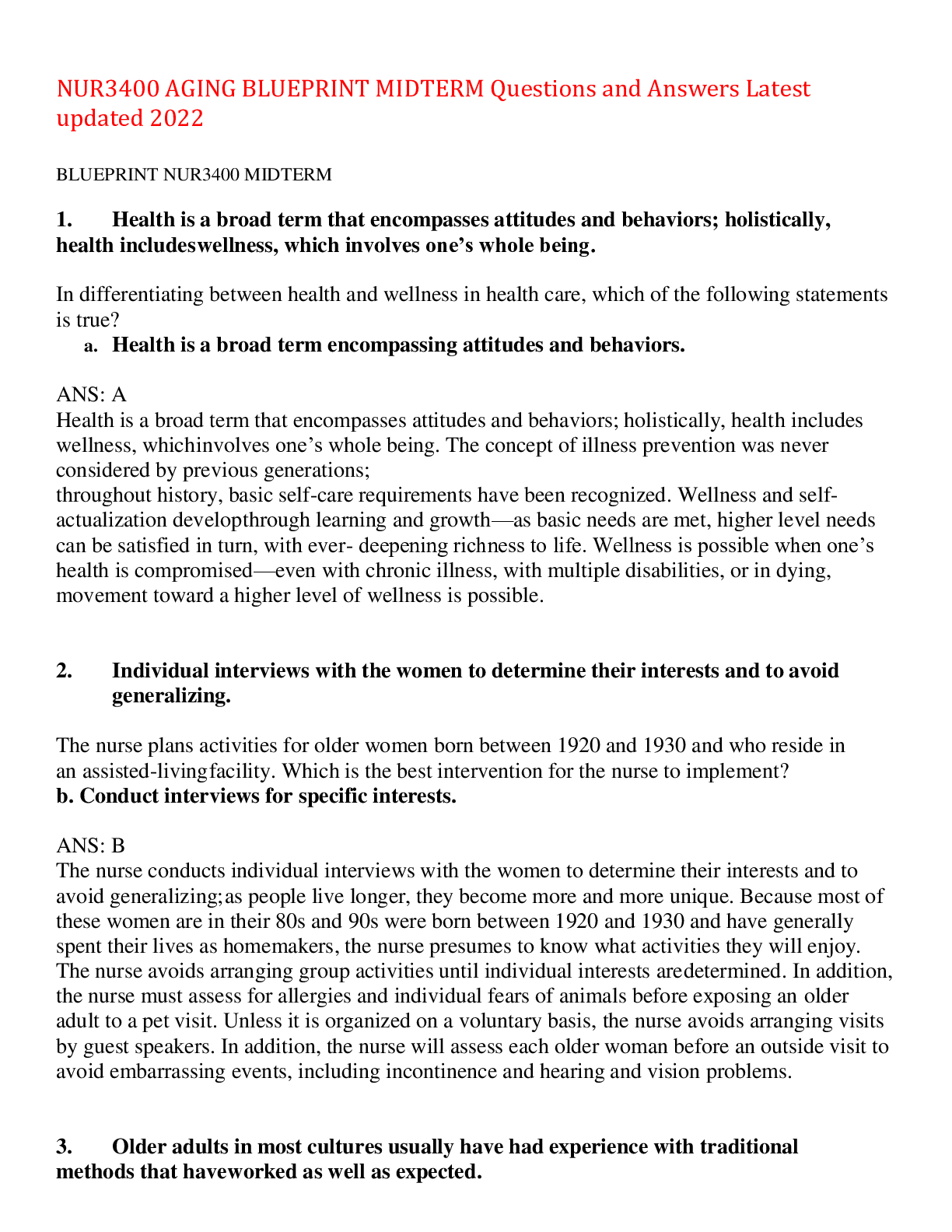
Instant download
Reviews( 0 )
Document information
Connected school, study & course
About the document
Uploaded On
Nov 21, 2022
Number of pages
51
Written in
Additional information
This document has been written for:
Uploaded
Nov 21, 2022
Downloads
0
Views
267

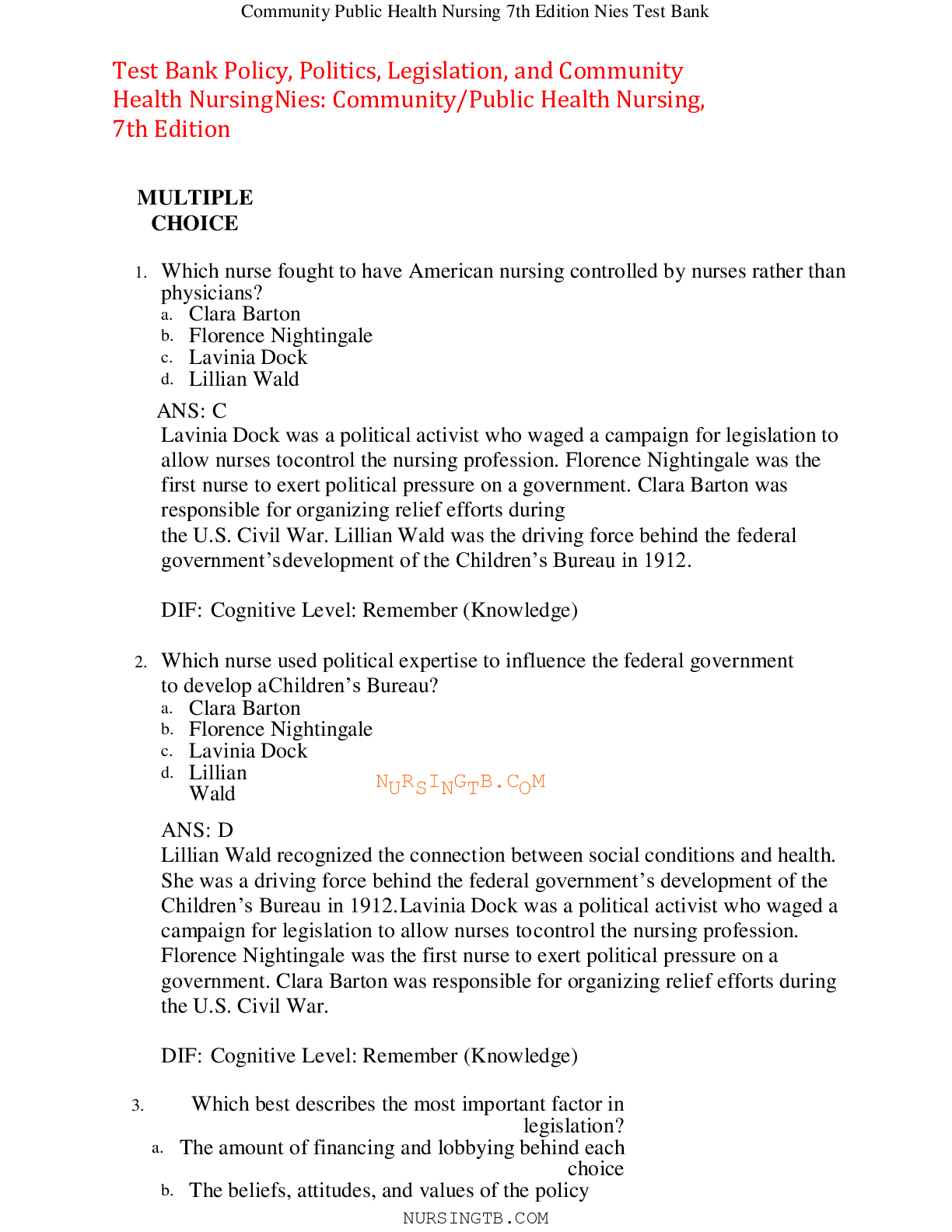


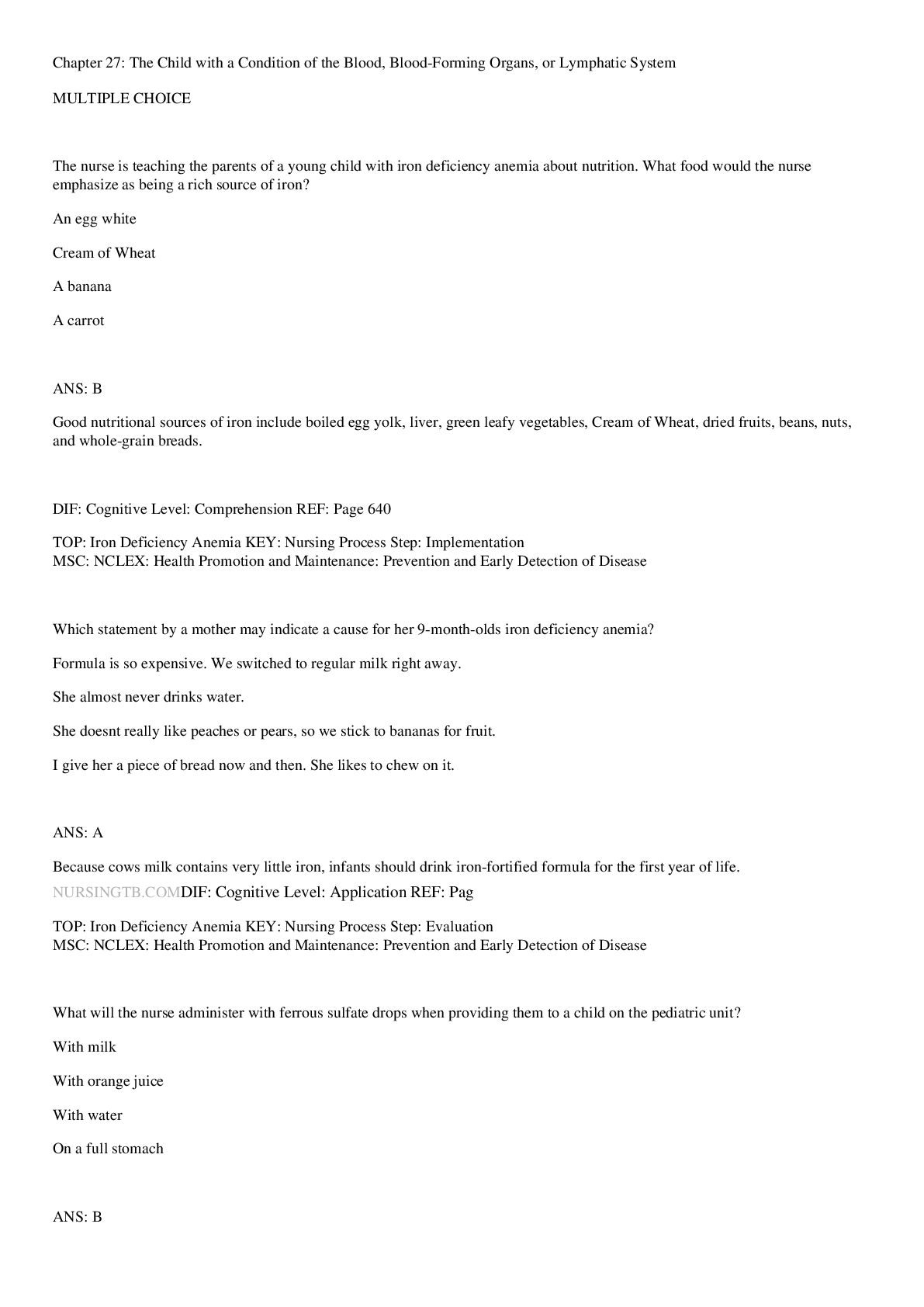



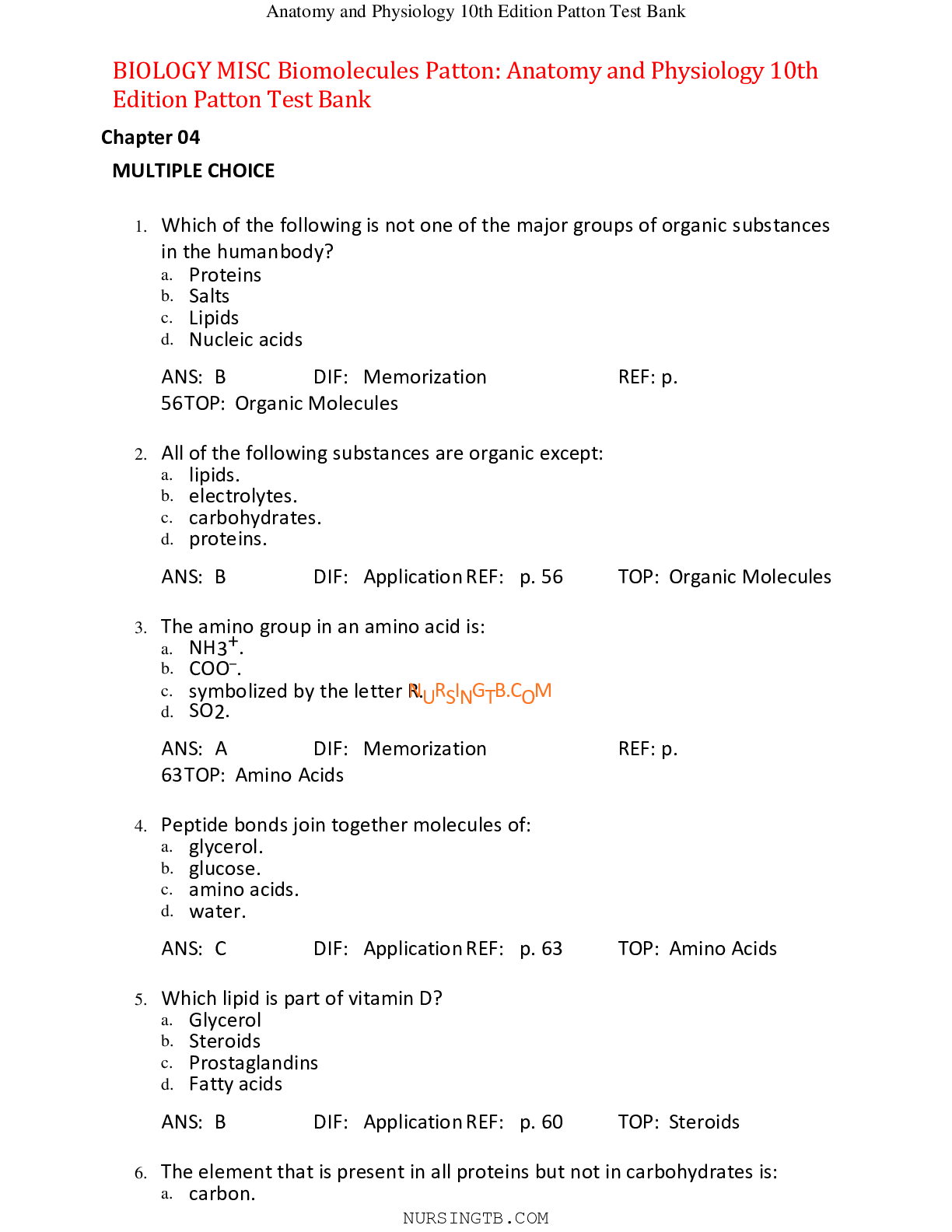







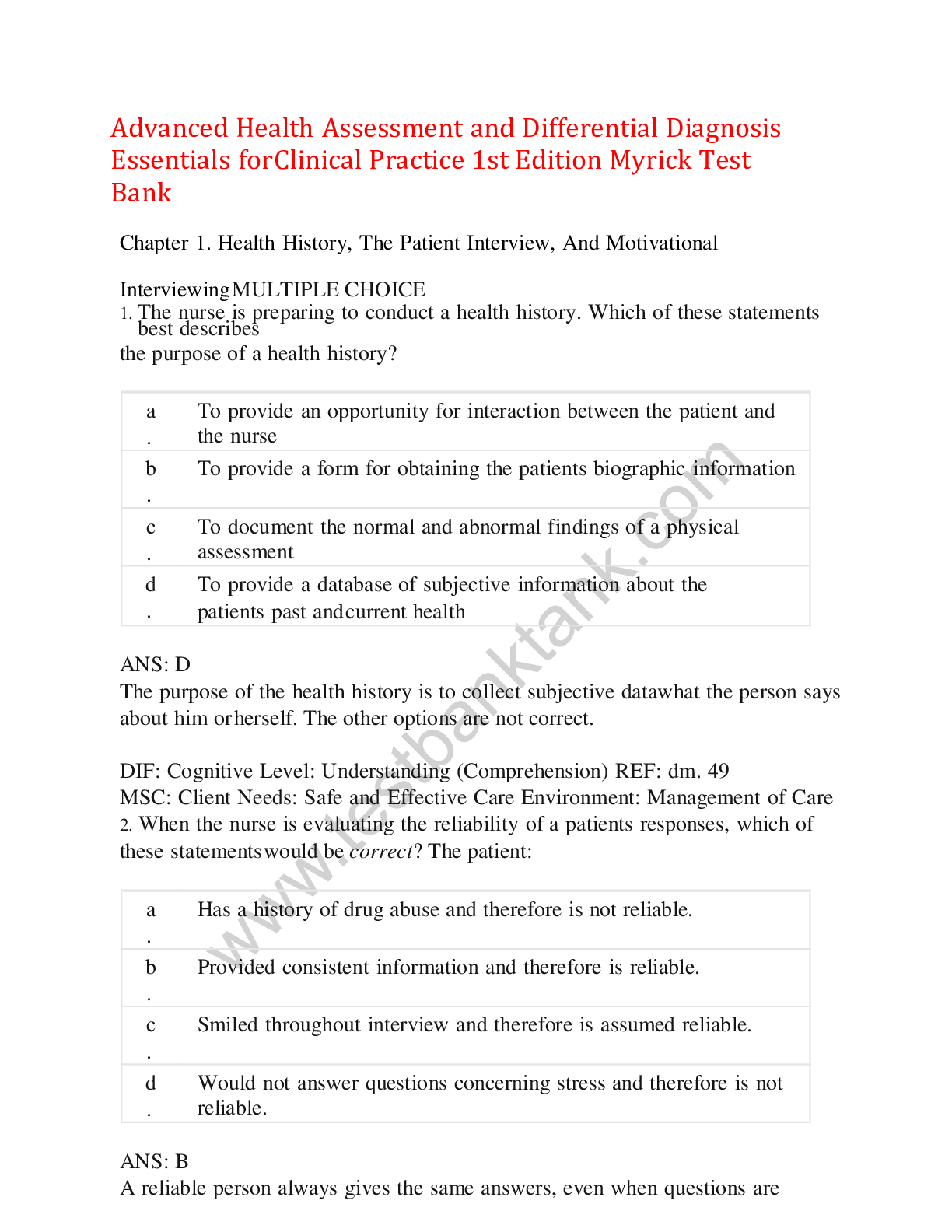
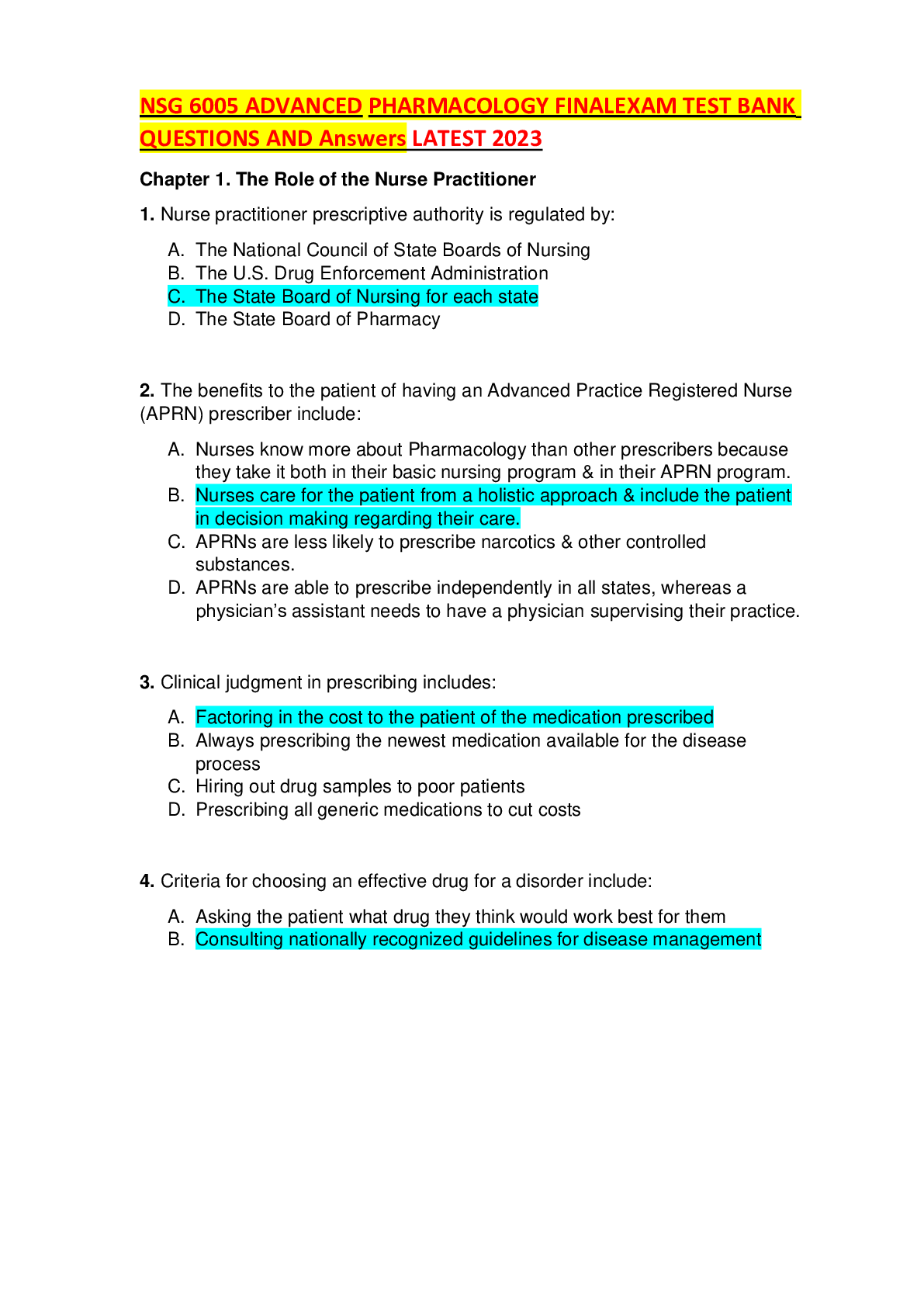


.png)
